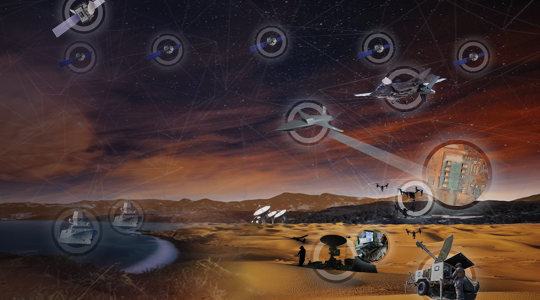
A panel from MilSatCom Symposium 2021 titled “Space and Ground Networking Architectures” addressed the growing need to provide more innovative and secure network architecture to better serve the DoD. As more satellites are launched, space and ground architecture are adapting to the growing need for data processing and transport. This is especially true for MILSATCOM, as thousands of contracts demand continued network architecture innovation to support growing mission needs.
There is a strong move toward pushing network processing and dissemination to orbit, in order to benefit from reduced latency and a reduction in the amount of raw data needed to be transmitted back to the ground. How will industry work together to innovate and provide these network architecture capabilities?
Mansat Executive Chairman and Founder Chris Stott moderated the panel, which included iDirect Government SVP of Technology Karl Fuchs, Microsoft Azure Space Senior Director Stephen Kitay, Former KSAT CEO Katherine Monson, Atlas Space Operations CEO Sean McDaniel, and Kratos Defense VP of Product Management Greg Quiggle as panelists.
Although the panelists brought diverse perspectives from both the space and the ground, they agreed on 3 key elements: putting the customer first, the power of partnerships, and building from the bottom up to ensure a secured system. If industry can follow suit, they will be set up for success when building the highly protected and resilient network architecture that the DoD demands.
After introductions, Fuchs dove into the discussion by addressing the security challenges he’s faced: “One of the hard lessons we’ve learned over the years is you can’t take a commercial platform – whether it’s ground infrastructure or space – and just expect to sprinkle on some extra little security things and have a defense grade platform. You really have to think through security architecture all the way from the ground up.”
He continued, commenting specifically on Low-Earth Orbit (LEO): “This is particularly pertinent as we start thinking about LEO constellations that aren’t simply bent pipe [satellites] – there’s active processing on the satellites themselves. That’s where the satellite demodulates, looks at a packet, and makes an intelligent routing decision like sending through inter satellite links, etc. … It’s vitally important that we begin working with those providers, so we can have a solid architecture that simply isn’t commercial where we try to squeeze in defense security requirements – that’s truly built from the ground up.”
The panelists were eager to share how they collaborate and take a partnership-driven approach. Kitay gave an example: “For instance, [Microsoft Azure’s] ground network of antennas that we’re building out for data centers – we’re looking to augment with people like KSAT and others here to integrate the work they are doing into our cloud computing architecture, to ultimately better serve the customers,” he said.
Kitay also explained that with the democratization of space and the development of new constellations, there is a vested interested from both the commercial segment and the military. “If we think about the military … there’s this tremendous focus on new activity that they are building out in space, and new constellations,” he said. “I think that really opens up the opportunity for hybrid architectures. How do you leverage this tremendous investment that’s happening in the commercial industry, and the unique requirements that Karl [Fuchs] talked about in security?”
Speaking about the ground, Monson addressed the military’s better buying power initiatives. “Particularly in the ground network side of the industry, we have huge economies of scale advantages when we can drive more volume. If we are able to build a network that is serving NASA and NOA, as well as the [U.S.] Air Force and Space Force, each of those government agencies is able to see a cost reduction, as well as expanded opportunity to use more locations – to have these hidden in plain sight architectures … it starts to become a less bifurcated effort,” she said.
Continuing the perspective from the ground, Quiggle also addressed the need for industry to work together. “If we don’t change the way that ground systems are built, the adoption won’t happen – the business cases don’t prove out in space, and then we don’t grow. It then turns into competition – but we have an opportunity right now to change that.”
He then reiterated the need for building a secure system: “As you expand the ecosystem, you bring know-how and expertise from these other industries … security is not an afterthought when you build one of these systems.”
